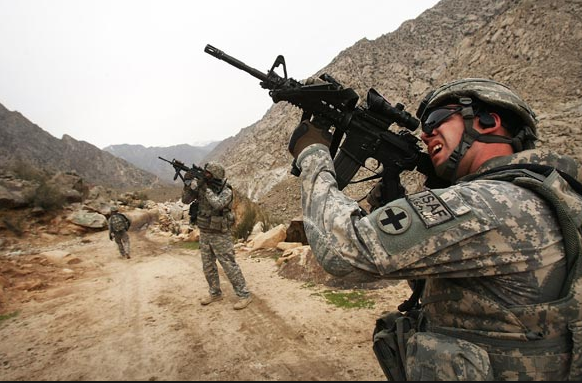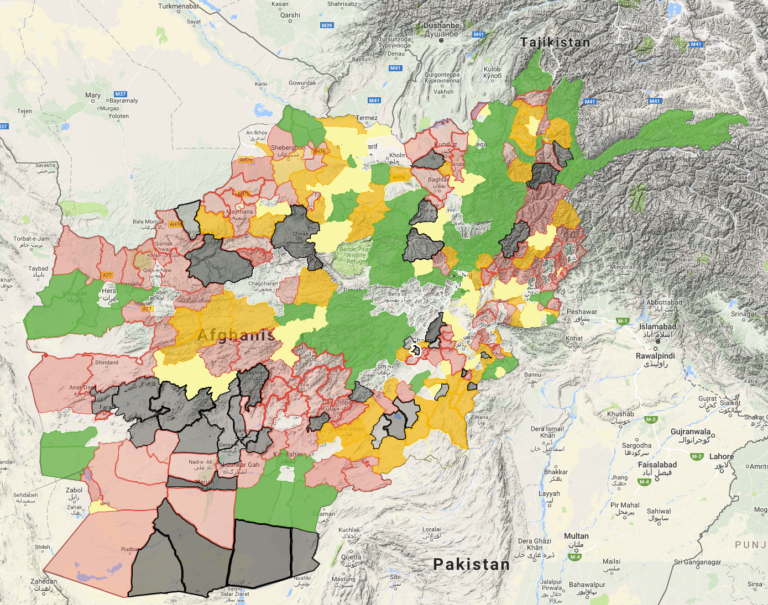
By Charlie Bausman
The United States is in its 16th year of military involvement in Afghanistan. 2,402 American troops have been killed in the conflict. 827 billion dollars have been spent since 2001.
The current administration is debating the path forward for American involvement in Afghanistan, which according to the media sources, has become a highly contentious topic within the White House.
Many MTI followers have spent many months or years in Afghanistan. We want to know what you think, and how you think the U.S. should move forward.
A Short History
The initial objective – the removal of Al Qaeda which perpetrated the 9/11 attacks and Taliban who provided a safe harbor for them, was mostly accomplished by early 2002.
Al Qaeda forces reportedly fled to neighboring Pakistan, and Taliban forces were removed from the district and urban centers.
Afghanistan became a secondary priority as the U.S. and allies toppled Saddam Hussein’s regime and battled the insurgency which followed. The Taliban re-emerged as a threat to security in Afghanistan, along with the Haqqani Network and several other insurgent organizations who oppose the Afghan government and western military involvement.
Following a major surge of American and allied forces into Afghanistan which successfully secured contested areas, western forces turned over responsibility to Afghan forces in 2014. The troop levels declined to the current manning of 8,400 used primarily in a advise and assist role.
Afghan forces have lost significant territory since the reduction of U.S. troops. The Taliban claims to fully control 34 districts and contests another 167. The Special Inspector General for Afghanistan Reconstruction (SIGAR) states that the Taliban controls, contests, or influences 171 districts. Islamic State forces are now also involved in the fighting.


The issues facing the Afghan government and its military have remained consistent.
- A dominant tribal influence which creates a significant cultural divide amongst Afghani’s
- Incredibly high levels of corruption by government and military officials
- Low levels of manning and training for Afghan military and police forces
- Increasing levels of opium production, often ‘taxed’ by insurgent elements for operational costs
- The relative safe haven of tribal areas in neighboring Pakistan
- Continued Green-on-Blue attacks by Afghan forces on U.S. service members
These factors decrease security for the populace, decrease confidence in the Afghan government, and strain the U.S.- Afghan relationship.
The 5 Policy Options
The Afghan policies currently discussed behind closed doors at the White House are not known in specific detail, but we do know the overarching ideas behind them.
More Troops
President Trump has approved Secretary of Defense Mattis to send up to 3,900 more troops to Afghanistan. These pre-approved troops have yet to be deployed, as Secretary Mattis attempts to clarify the policy positions of the Trump administration.
The proponents of additional troops make up the majority of the administration’s national security team – National Security Advisor H.R. McMaster, SecDef Mattis, SecState Tillerson, General Dunford (Joint Chief of Staff) and General Nicholson (Commanding General of American forces in Afghanistan) all recommend additional troops.
The additional troops would provide further training, equip, and support for Afghan forces. No timeline has been specified for a troop increase, which was a source of contention during the Obama administration, possibly allowing insurgent groups to ‘wait out’ U.S. forces.
Former security officials such as Jack Keane and Leon Pancetta have stated that the 3,900 troop increase is not nearly enough to make an impact on the security situation in Afghanistan.
Full Withdrawal
The Wall Street Journal reported on July 30th that some members of the Trump administration were exploring the possibility of a full withdrawal from Afghanistan.
This option may have been taken off the table according to the Washington Times, but it displays the frustration of Trump officials over policy options in Afghanistan. White House Chief Strategist Steve Bannon supposedly support further exploring this option.
Status Quo
This isn’t necessarily an option anyone is recommending, but rather the ground level fact as the deadline for an Afghan policy sits over due. Troop levels remain the same with the same mission sets.
The status quo has been described as an eroding stalemate as the Taliban and other groups retake ground from the Afghan government.
The Contractor Option
Erik Prince, the founder of Blackwater and other military contracting businesses, proposed a private military contractor option for Afghanistan. He penned an op-ed in the Wall Street Journal and has recently made the television media rounds.
He recommended the establishment of a lead federal leader or ‘viceroy’ with private military advisors implemented at the Afghan battalion level in the fight against the Taliban. Prince also recommended a model based loosely on the Britsh East India Company, which served as the private business arm of the colonial effort in the Americas and India.
(CLICK HERE to see a recent interview with Prince on the topic.)
This idea was apparently met with contempt by H.R. McMaster and Secretary Mattis, but administration officials such as Steve Bannon and Jared Kushner have enabled Prince to gain the ear of the President.
Previous Options – Biden’s CT Plus
During the Obama administrations deliberations on Afghan Policy, Vice President Biden proposed reducing COIN focused troop levels, instead emphasizing counter-terrorism operations by special operations forces.
This would have focused on removing insurgent and terrorist leadership elements along with logistical support, and letting go of the counter insurgency based doctrine which required much higher troop levels of conventional forces.
This option was not chosen but likely remains in the minds of some officials as the Taliban continues to regain territory.
What do you think we should do?
Many MTI followers have been deployed to Afghanistan in some capacity. Collectively, this represents a tremendous opportunity to learn from these personal experiences and apply them to the strategic level policy discussion. We want to know what you think. Please answer the survey below – all answers will be completely anonymous.
Sources
https://www.reuters.com/article/us-usa-afghanistan-trump-idUSKBN1AM0F5
https://www.thecipherbrief.com/article/asia/u-s-running-out-of-options-in-afghanistan
https://www.armytimes.com/flashpoints/2017/07/31/trump-considers-withdrawal-from-afghanistan/
http://www.slate.com/articles/news_and_politics/war_stories/2009/03/ct_or_coin.html
https://www.wsj.com/articles/the-macarthur-model-for-afghanistan-1496269058
STAY UPDATED
Sign-up for our BETA newsletter. Training tips, research updates, videos and articles - and we’ll never sell your info.
